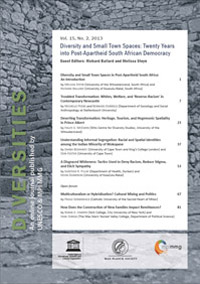Understanding Informal Segregation: Racial and Spatial Identities among the Indian Minority of Mokopane
by Sahba Besharati (University of Cape Town and King’s College London) and
Don Foster (University of Cape Town)
To cite this article: Besharati, S., & Foster, D. (2013). Understanding Informal Segregation: Racial and Spatial Identities among the Indian Minority of Mokopane. Diversities, 15(2), 37–51. https://doi.org/10.58002/78hv-fv63
Although South Africa’s history has brought a great deal of research attention to racial dynamics in the post apartheid period, much of this research has been on the largest demographic groups in urban centres. This study focuses on the spatial arrangement of minority identities, through continued informal segregation, among the Indian minority of Mokopane. Drawing on 28 open-ended interviews, segregation is explored in everyday interactions and spaces. Working within a spatial-discursive framework, observational, critical discourse and rhetorical analysis is employed. Participants’ discursive constructions overwhelmingly demonstrate patterns of informal segregation among the Indian minority community, within the micro-ecology of contact. It is argued that informal segregation acts as a regulator of hostile and hidden racism. In mapping the dialogue of the Indian minority, a story of the evolution of segregation emerges, which replicates internal divisions between the established ‘South African Indians’ and recent ‘immigrant Indians’. This study ultimately demonstrates the need for a spatial-discursive orientation and a more “embodied” turn in our understanding of segregation.
Keywords: minority groups, micro-ecology of contact, segregation, race relations, spatial identity
|
